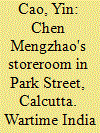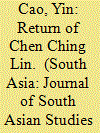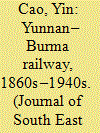| Srl | Item |
| 1 |
ID:
191122


|
|
|
|
|
| Summary/Abstract |
This article is about the experiences of three Chinese men who were involved in smuggling between India and China during the Second World War. Chen Mengzhao's rise as a leading figure in India-China smuggling in Calcutta uncovers the hidden links between the black markets in India and China during the Second World War. Gao Wenjie disguised himself as a Chinese army officer and utilized this fake identity to facilitate his smuggling business. Wang Li-an was sent to Calcutta to undertake smuggling for a Chinese government department. In telling these stories, this article argues that most smuggling in modern India and China was undertaken in transnational contexts that resulted in transnational effects. Ironically, the Nationalist government's state-building project to contain India-China smuggling ended by facilitating it. This project was further perceived by the British authorities as a Chinese conspiracy against India's sovereignty. The misunderstanding between the Chinese and British authorities led to the end of Chinese immigration to India in 1945. Overall, this article provides a new perspective to make sense of the tensions between the Chinese, Indian, and British governments during the Second World War.
|
|
|
|
|
|
|
|
|
|
|
|
|
|
|
|
| 2 |
ID:
183810


|
|
|
|
|
| Summary/Abstract |
This article centres on the evacuation of the Lahore Elementary Flying Training School, which was built in 1943 to train Chinese pilots and mechanics. It details the British and Chinese authorities’ concerns over the school and how the chaotic situation in India during the final days of the British Raj influenced its evacuation back to China. This article locates the story within the broad context of the British withdrawal from India and the Chinese Civil War, and it uses this case to uncover the links between the two most significant events in the history of modern India and China. In so doing, it puts forward an integrated framework for studying modern Indian and Chinese history.
|
|
|
|
|
|
|
|
|
|
|
|
|
|
|
|
| 3 |
ID:
181677


|
|
|
|
|
| Summary/Abstract |
During World War II, thousands of Chinese soldiers were sent to India for training. Many of them deserted from the army and made a new life in India. Chen Ching Lin was one of these deserters. Following the course of his journey in India from 1943 to 1946, this article not only unearths the little-known experiences of the Chinese deserters in India, but also explores how the Chinese Nationalist Government’s aim to discipline the overseas Chinese communities conflicted with the agenda of British geopolitics. It further contends that modern Chinese and Indian history could be integrated into a single narrative framework from subaltern perspectives.
|
|
|
|
|
|
|
|
|
|
|
|
|
|
|
|
| 4 |
ID:
191697


|
|
|
|
|
| Summary/Abstract |
In the late nineteenth century, British commercial interests in Asia and back home visualised a railway connecting British Burma with inland China, which they saw as a vast unexplored market. British engineers and adventurers were then employed by the commercial bodies to investigate the economy and geography of Yunnan and Upper Burma for the project. The railway was eventually rejected by the British as being unviable and unprofitable. The colonial knowledge created by these missions (in the form of travelogues, survey reports, interviews and studies) was later interpreted by Chinese nationalists as evidence of Britain's ambitions to colonise southwest China in 1905 (the Russo-Japanese War) and 1927 (the Northern Expedition) when the Chinese nation was in deep crisis. But the outbreak of the Second Sino-Japanese War led the Chinese Nationalist government to reconsider the Yunnan–Burma railway as necessary infrastructure for obtaining foreign supplies to save the nation. The colonial knowledge produced by British explorers and merchants earlier was reinterpreted by the Nationalists to try to persuade the British authorities to construct the Burma section of the railway. By tracing the history of this failed project, this article argues that nationalist understandings of colonial infrastructure were far from fixed and consistent. It recounts the circulation of colonial knowledge on the Yunnan–Burma railway from the late nineteenth to the early twentieth century, showing how different nationalist agents in Asia interpreted and reinterpreted colonial infrastructure at various critical periods.
|
|
|
|
|
|
|
|
|
|
|
|
|
|
|
|